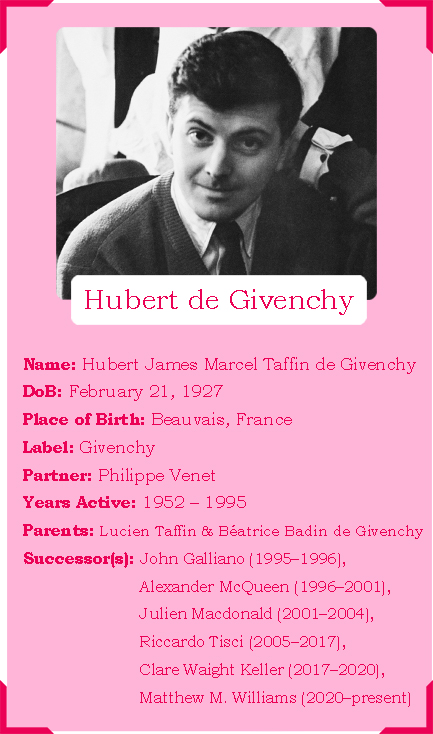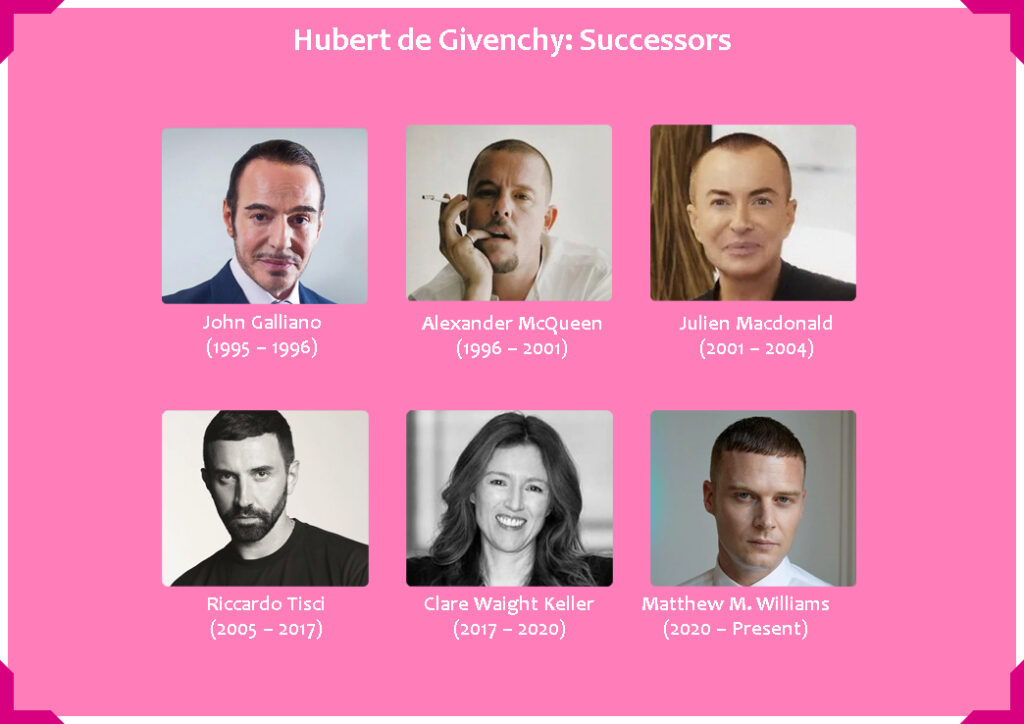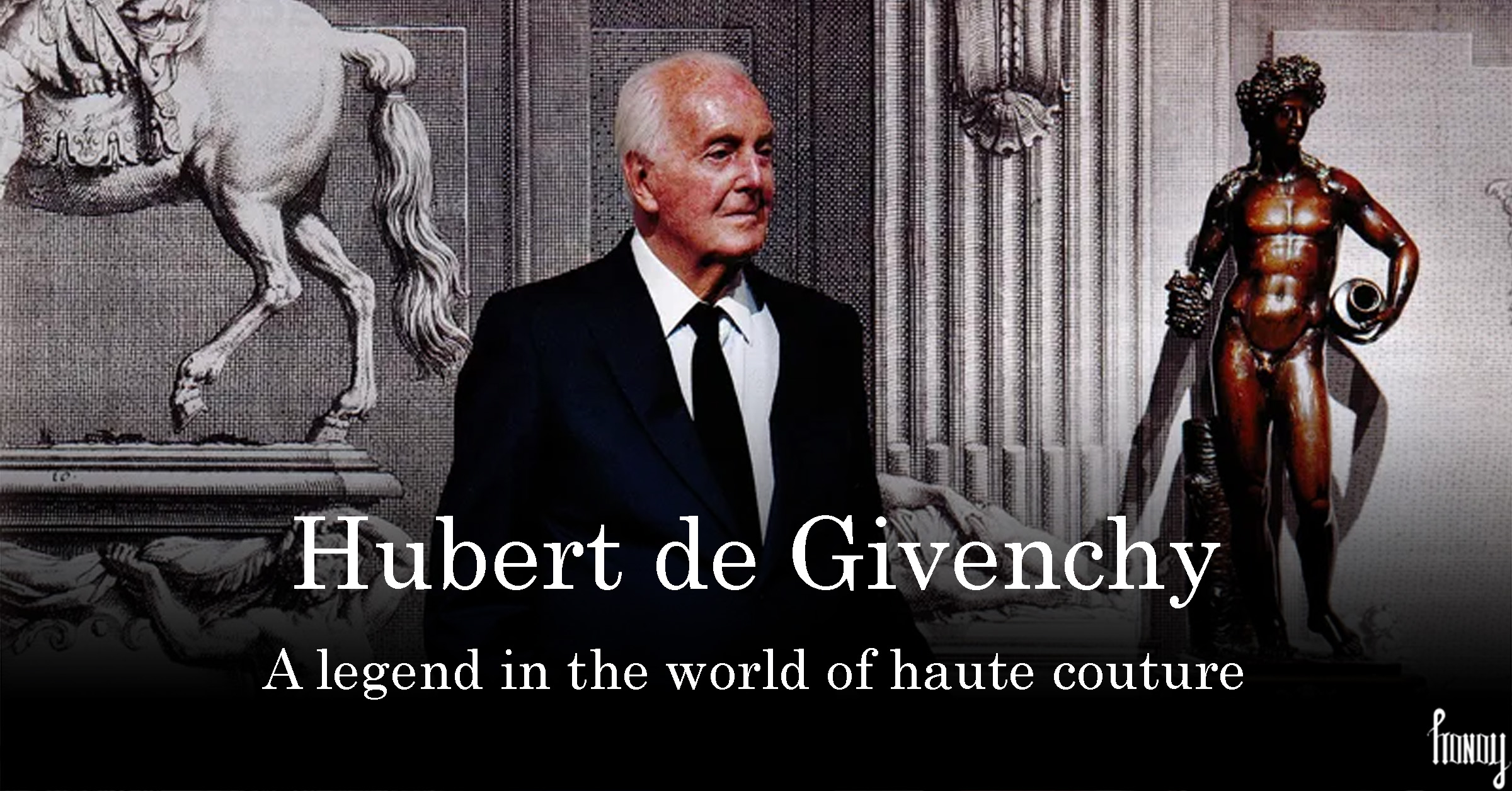Introduction to Hubert de Givenchy

Count Hubert James Marcel Taffin de Givenchy, who is considered one of the legends of the world of the haute couture, is a French fashion designer par excellence and influence. With his unparalleled vision and creations throughout his life, he has given the world of fashion an unparalleled archive of iconic designs, creativity, and timeless elegance. He single-handedly founded the house of Givenchy, one of the most influential fashion brands of modern times.
From dressing world royalty to Hollywood stars and along the way shaping the fashion landscape with his unique designs. Givenchy’s influence continues to resonate in the fashion industry and the world all over even today. In this blog, we delve into the life and legacy of this visionary designer, highlighting his notable contributions and enduring impact on the world of fashion.
Early Life and Rise to Fame

Born on February 20, 1927, in Beauvais, France, Hubert James Marcel Taffin de Givenchy showed an early interest in fashion and design. He studied at the École des Beaux-Arts in Paris before launching his eponymous fashion house in 1952. Givenchy’s impeccable taste and innate sense of style quickly caught the attention of the fashion elite, establishing him as one of the leading couturiers of his time.
Givenchy made his first designs for French fashion designer Jacques Fath in 1945. He later also designed for Robert Piguet and Lucien Lelong. From 1947 to 1951 he worked for the avantgarde designer Elsa Schiaparelli. Working with all these superior fashion designers of their times, trained Givenchy in the highest standards of dress making culture. Givenchy retired from the world fashion design in 1995. He died in his sleep at the Renaissance chateau near Paris on Saturday 10 March 2018.
Notable Contributions to the Fashion World
During his entire career as a fashion designer Hubert de Givenchy made uncountable significant contributions to the fashion world. We shall look into some of the most prominent of those: his designs were characterized by their clean lines, luxurious fabrics, and understated elegance. He pioneered the “sack dress” silhouette in the 1950s, challenging traditional notions of femininity and redefining modern glamour.
One of his most famous creations is the “little black dress” worn by Audrey Hepburn in the classic film “Breakfast at Tiffany’s” (1961). This sleek and simple silhouette, accessorized with pearls and gloves, epitomized Givenchy’s signature style. Another notable design is the “Bettina blouse,” named after his muse Bettina Graziani, which featured billowing sleeves and a fitted waist.
Not just the womens wear , he also contributed to the world of men’s fashion with the Givenchy Gentleman Suit. Introduced in 1974, the Givenchy Gentleman suit revolutionized men’s fashion with its modern tailoring and refined aesthetic, solidifying his reputation as a leading menswear designer.
Relationship with Audrey Hepburn
The relationship between Audrey Hepburn and Hubert de Givenchy was one of the most iconic partnerships in the history of fashion. It began in 1953 when Hepburn, already a rising Hollywood star, sought out Givenchy’s designs for her upcoming film “Sabrina.” Givenchy, who had mistaken her for Katharine Hepburn initially, was immediately captivated by Audrey’s grace and elegance.
Their collaboration blossomed, with Givenchy becoming Hepburn’s exclusive couturier both on and off-screen. He designed her wardrobe for several of her most memorable films, including “Sabrina” (1954), “Funny Face” (1957), and “Breakfast at Tiffany’s” (1961). The now-famous “little black dress” worn by Hepburn in “Breakfast at Tiffany’s” became one of Givenchy’s most iconic designs and solidified their partnership as legendary in the world of fashion.
Their friendship extended beyond professional collaborations, with Hepburn often wearing Givenchy’s designs to public events and award ceremonies. The bond between them was characterized by mutual respect, admiration, and a shared appreciation for elegance and sophistication to the point that the actress described the designer as her “best friend” and he, in turn, said he saw her as a “sister”.
Their partnership continued to flourish over the years, with Givenchy creating numerous custom designs for Hepburn, including her wedding dress when she married Andrea Dotti in 1969. Even after Hepburn’s retirement from acting, she remained a loyal friend and muse to Givenchy until her passing in 1993.
Perfumes and Accessories
In addition to clothing, Givenchy expanded his brand to include perfumes and accessories. His debut fragrance, “L’Interdit,” launched in 1957, became an instant classic. Its name, meaning “forbidden” in French, was inspired by his close friend and muse, Audrey Hepburn. The perfume featured a sophisticated blend of floral and woody notes, encapsulating Givenchy’s timeless aesthetic.
With this success, Givenchy set the stage for future fragrance releases, including “Givenchy Gentleman” (1974) and “Organza” (1996). Launched in 1996, Organza was a tribute to femininity, featuring a luxurious blend of floral and oriental notes. The perfume was housed in an elegant bottle adorned with a delicate organza ribbon, reflecting Givenchy’s attention to detail and craftsmanship. Introduced in 1974, he Gentleman revolutionized men’s fragrances with its modern and refined scent. The fragrance embodied the essence of a true gentleman, with notes of patchouli, vetiver, and leather, reflecting Givenchy’s sophisticated approach to menswear.
Legacy in the Fashion World
Hubert de Givenchy’s legacy in the fashion world is influential to the highest order. Impact of designs and creativity is still felt across the industry, with his designs serving as a source of inspiration for generations of designers. Let’s look at some of those aspects:
Givenchy’s work as a couturier redefined elegance for the women in the highest echelons of the society. He is credited with the innovation of countless silhouettes like Little Black Dress, Bettina Blouse, Sabrina Dress, , Balloon Coat, Baby Doll Dress, Envelope Dress, Mermaid Gown and many more. These designs are now considered as classics as they continue to be reinterpreted and inspires new wave of designers. These classic silhouettes and their meticulous attention to detail have stood the test of time, remaining relevant and coveted by fashion enthusiasts worldwide.
Through his innovative designs, Givenchy challenged traditional notions of femininity and beauty. He empowered women to embrace their individuality and express themselves through fashion, setting a new standard for modern elegance. By embracing Minimalism, he often created designs that featured clean lines, simple silhouettes, and understated elegance, diverging from the elaborate and ornate styles prevalent in haute couture at the time. By embracing minimalism, Givenchy emphasized the beauty of simplicity and showcased that less can indeed be more.
Givenchy redefined femininity by not conforming to stereotypical ideals prevalent at the time. His designs celebrated individuality and empowered women to embrace their uniqueness. He favored tailored suits, sleek dresses, and structured pieces that emphasized confidence and sophistication, challenging the notion that femininity equates to frills and flounces. His partnership with Audrey Hepburn played a significant role in challenging conventional beauty standards. Hepburn’s petite frame and gamine features defied the prevailing Hollywood glamor of the time, yet his friend’s designs beautifully complemented her natural elegance, showcasing a different, more understated form of beauty that resonated with audiences worldwide.
Givenchy was known for incorporating elements of menswear into his women’s collections, blurring the lines between gendered fashion and challenging traditional notions of femininity. His tailored jackets, crisp shirts, and sleek trousers added a touch of androgyny to his designs, offering women a new way to express themselves through fashion.
Successors of the House of Givenchy
John Galliano (1995 – 1996): John Galliano was the first British designer to lead the prestigious House of Givenchy after its founder, Hubert de Givenchy, stepped down in 1995. Known for his dramatic and theatrical designs, Galliano brought an avant-garde flair to the brand. His tenure, though brief, was marked by collections that balanced Givenchy’s classic elegance with his own imaginative and bold style. Galliano’s artistic direction caught the attention of the fashion world and laid the groundwork for a new era of creativity at this legendary French fashion house. However, his stint lasted just a year, as he was soon appointed to lead Christian Dior.
Alexander McQueen (1996 – 2001): Alexander McQueen, who succeeded John Galliano in 1996, brought a darker, more provocative aesthetic to Givenchy. Known for his avant-garde designs and controversial shows, McQueen introduced an edgier, more daring side to the brand while staying true to its couture roots. His tenure included iconic collections that merged traditional tailoring with surrealism and gothic elements. Though his boundary-pushing vision was polarizing, it reinvigorated the house’s creative direction. McQueen’s time at Givenchy ended in 2001, but his influence left an indelible mark on the brand, showcasing its ability to embrace bold reinvention.
Julien Macdonald (2001 – 2004): Julien Macdonald, a British designer renowned for his glamorous and opulent designs, took over Givenchy in 2001. His collections emphasized glitz, evening wear, and intricate details, making use of luxurious materials like lace and sequins. While he succeeded in bringing red-carpet appeal to Givenchy’s collections, his focus on glamour clashed with the house’s traditional elegance, leading to mixed reviews. Macdonald’s tenure ended in 2004, and although his direction didn’t align perfectly with the brand’s heritage, he contributed to elevating Givenchy’s status in the celebrity fashion sphere.
Riccardo Tisci (2005 – 2017): Riccardo Tisci’s appointment as creative director in 2005 marked a transformative period for Givenchy. Known for his gothic, streetwear-inspired aesthetic, Tisci redefined the brand’s identity by blending elements of romanticism, sensuality, and urban edge. His collections often featured religious iconography, sharp tailoring, and intricate embellishments. Under his leadership, the business experienced unprecedented growth and popularity, especially among celebrities like Beyoncé and Kanye West. Tisci’s 12-year tenure is credited with making the house of Givenchy a symbol of modern luxury and bridging the gap between haute couture and contemporary street fashion.
Clare Waight Keller (2017 – 2020): Clare Waight Keller became the first woman to lead the house of Givenchy when she was appointed in 2017. Known for her refined, elegant designs, Keller brought a softer and more feminine touch to the brand, reinterpreting the house codes with a sense of sophistication and subtlety. Her most iconic moment was designing Meghan Markle’s wedding dress for her marriage to Prince Harry in 2018, which garnered global acclaim and solidified Keller’s position in fashion history. During her tenure, Keller reintroduced the house’s emphasis on couture craftsmanship and timeless style before departing in 2020.
Matthew M. Williams (2020 – Present): Matthew M. Williams, a designer known for his work with streetwear label 1017 ALYX 9SM, became the brand’s creative director in 2020. His appointment signaled a new direction for the brand, blending urban influences with Givenchy’s legacy of refined elegance. Williams’ collections emphasize utilitarian aesthetics, modern tailoring, and innovative use of materials, appealing to a younger, fashion-forward audience. Despite taking on the role during a challenging time globally, his approach has been lauded for pushing the boundaries of the brand’s identity and introducing a fresh perspective that aligns with contemporary fashion sensibilities.

Cultural Impact
Givenchy was not afraid to experiment with unconventional materials and innovative techniques, pushing the boundaries of traditional craftsmanship. From incorporating plastic and metal into his designs to experimenting with new forms of embroidery and construction, he constantly pushed the envelope in pursuit of artistic expression. His collaborations with Audrey Hepburn and other cultural icons solidified his place in fashion history. His creations transcended the runway, becoming iconic symbols of style and sophistication.
Conclusion
Hubert de Givenchy’s legacy not just as a fashion couturier but also as an innovator and breaker of barrier continues to shine brightly in the world of fashion, inspiring designers and captivating audiences with his timeless elegance and innovative designs. From his iconic collaborations with Audrey Hepburn to his pioneering contributions to haute couture, Givenchy’s influence is felt in every stitch and silhouette. As we celebrate his remarkable career and enduring impact, we are reminded of the transformative power of fashion to inspire, empower, and uplift.
He may have left us, but his legacy lives on, forever etched in the annals of fashion history. Please share with us your favourite creation form this legend of a designer and also tell us how you like our blog, and if we have missed on any key information in this post.





























Pingback: Top 10 Fashion Blogs Of The World
Pingback: Evening Gowns: A Story Of Grace And Beauty In 5 Mins